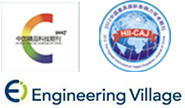Abstract:
Carbon fiber-epoxy resin composites have excellent properties such as high strength and high modulus, corrosion and fatigue resistances, and are widely used as structural materials in civil engineering. Nylon 6 has advantages of great fracture toughness, self-lubrication, friction and wear reduction, etc. Its incorporation as a filler in short-cut carbon fiber-epoxy composites is expected to significantly improve mechanical and frictional wear properties. In this paper, a high performance composite with excellent mechanical properties, high temperature resistance, low coefficient of friction and wear rate was prepared through using short-cut carbon fiber-epoxy resin composites modified with nylon 6 based on the resin selection method. The effect of the addition of nylon 6 on the thermal, mechanical and frictional wear properties of composite was investigated, and the mechanism of nylon 6 on its performance enhancement was revealed by combining microscopic morphology and structural analysis. It was found that the tensile fracture toughness of the modified composites increased by 199% with the addition of 7.5wt% nylon 6, and the fracture damage mode changed from brittle fracture to ductile fracture, the tensile fracture morphology changed from "plain" to "gully" and the glass transition temperature increased by 15.2℃. The addition of 10wt% nylon 6 significantly reduced the frictional coefficient (~80%), wear rate (~53%), scratch width (~22%) and line roughness (~15%) of the composites. The improvement mechanism can be attributed to the fact that nylon 6 assisted in the formation of a uniform and dense lubricant isolation film on the scratch surface, which changed the wear type of the composites from the severe fatigue wear to the slight adhesive wear or abrasive wear.


 下载:
下载: